This post may contain affiliate links. Please see our disclosure policy.
Peach jelly captures the delicate sweetness of summer peaches in a smooth, spreadable preserve—without the pulp or chunks you’d find in jam. It’s the perfect way to highlight the flavor of fresh fruit, and it looks beautiful on the shelf too!
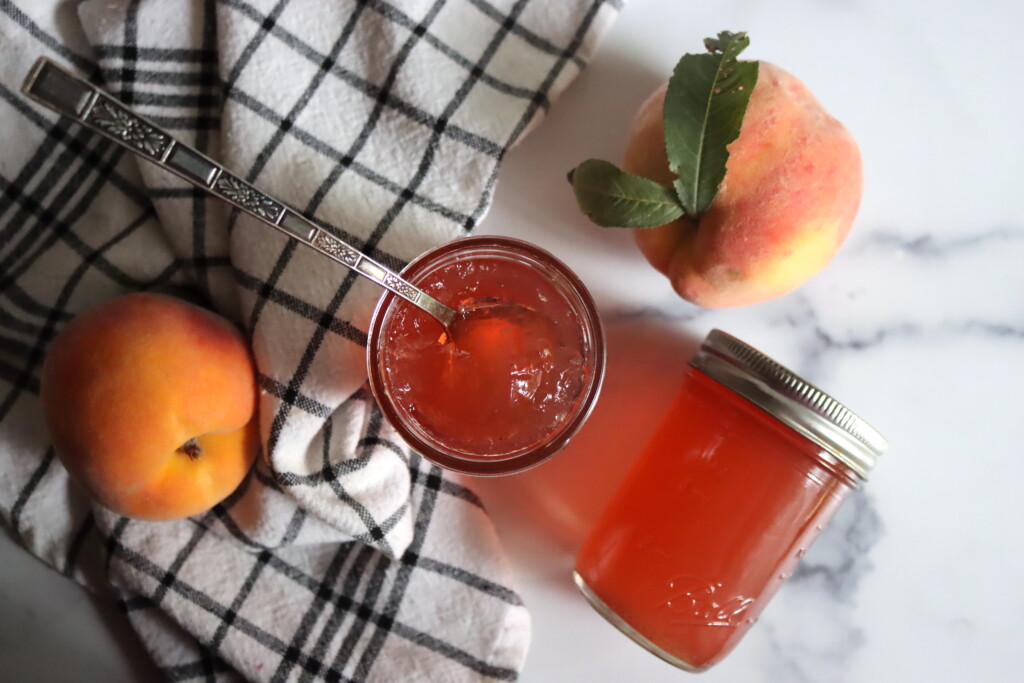
We always seem to have a few too many peaches at the height of summer. Some get eaten out of hand, a few go into pies and cobblers, and we even make peach wine. Still, at the end of canning season when the peaches just won’t quit, I turn to peach jelly. It’s one of the simplest ways to preserve the essence of a ripe peach, and once you’ve made it once, you’ll want to make a batch every season.
The best part? You don’t even need to fuss with peeling or pitting the peaches! The first step in this recipe is to extract the peach juice, which is surprisingly easy and yields a delicious base for your jelly.
It’s perfect for when you want to put up the last of the season’s peaches, but you’re all out of patience for the peeling and processing that’s required when canning peaches, peach jam or making home canned peach pie filling.
(Oh, and this recipe works with other stone fruits too, so you can use it to make nectarine jelly, apricot jelly or plum jelly too!)
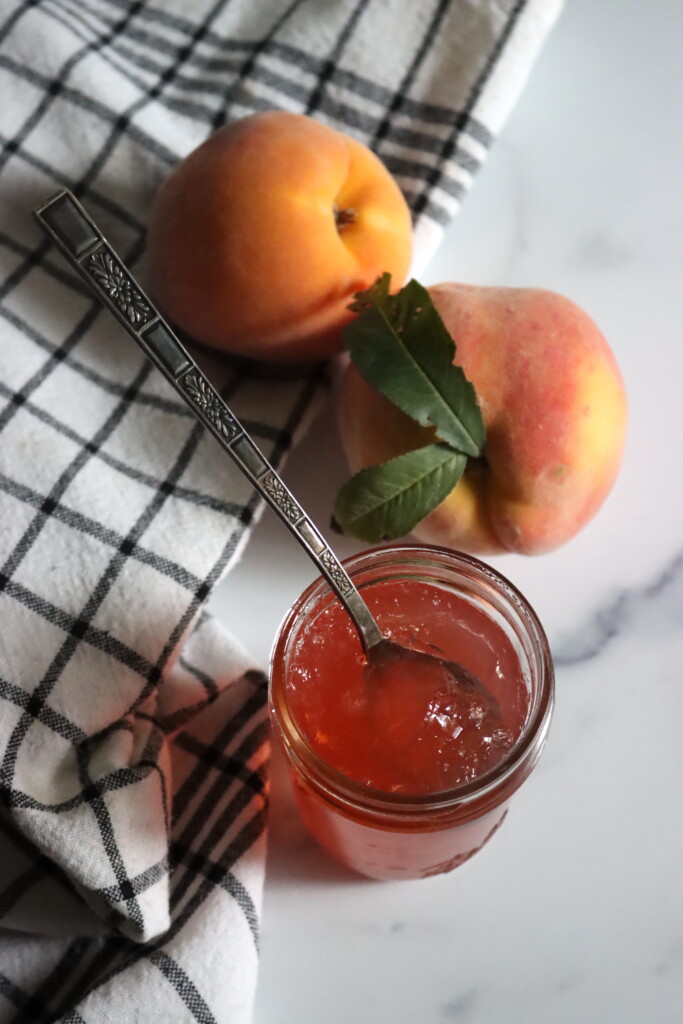
Peach Jelly Ingredients
Peach jelly is made with just a handful of simple ingredients, but each one plays an important role in flavor, texture, and safety. Here’s a quick look at what goes into the recipe—and a tip for making a no-waste version using peach peels.
- Peach Juice – This is the base of your jelly, made by simmering and straining fresh peaches. You’ll need about 12 medium peaches and 2 cups of water to yield 4 cups of juice. The flavor comes entirely from the fruit, so use ripe, juicy peaches at their peak for the best results.
- Pectin – Regular powdered pectin, like Sure-Jell, helps the jelly set properly. Without it, peach juice alone doesn’t have enough natural pectin to gel. Make sure you’re using the correct type of pectin for the sugar ratio in your recipe—low-sugar pectin if reducing the sugar, or standard pectin if making a full sugar batch.
- Sugar – The sugar not only sweetens the jelly, but also helps preserve it and create that classic jelly texture. You can reduce the sugar if you’re using a low-sugar pectin, cutting it down to 1–2 cups for a softer-set, more fruit-forward jelly.
- Lemon Juice – If your peaches are particularly sweet, a little lemon juice adds brightness and helps balance the flavor. It’s optional in this recipe, but a good addition if you want a hint of tartness to round out the sweetness.
Peach Peel Jelly Option: If you’re canning peaches and want to make the most of every bit, don’t toss those peels! You can make jelly using just the peels—use roughly 1 pound of peach peels for each cup of juice you want to extract. Simmer the peels in water just as you would whole fruit, then strain. Since the peels are where pesticide residue can concentrate, make sure you’re using organically grown peaches if you go this route.
With these ingredients, you can create a smooth, golden jelly that brings the flavor of ripe summer peaches to your pantry shelf—whether you’re working with whole fruit or giving a second life to those fragrant peach peels.
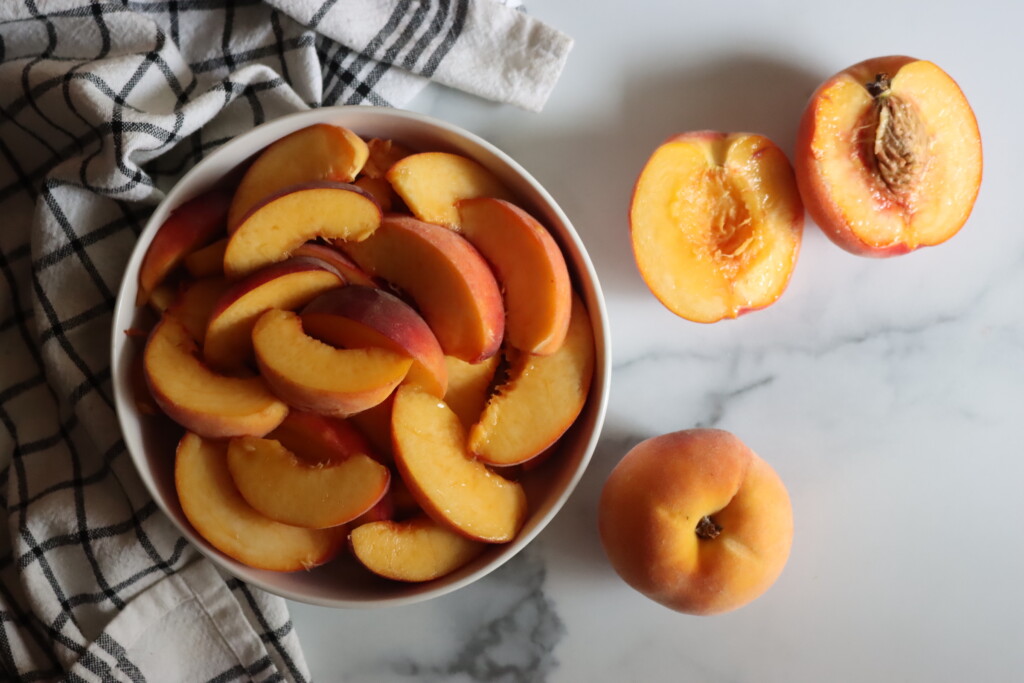
Extracting Peach Juice
The first step to making peach jelly is extracting juice from the fruit. You don’t need to peel the peaches, but it helps to quarter them and remove the pits if you want a clearer juice.
Add about 12 medium peaches to a pot with 2 cups of water, bring them to a boil, and then simmer gently for about 20 minutes. Stir occasionally to help break them up and release the juice. Once they’re soft, strain the mixture through a jelly bag or cheesecloth. Let it drip slowly for at least 2 hours—overnight is even better. The result should be about 4 cups of peach juice, perfect for one batch of jelly.
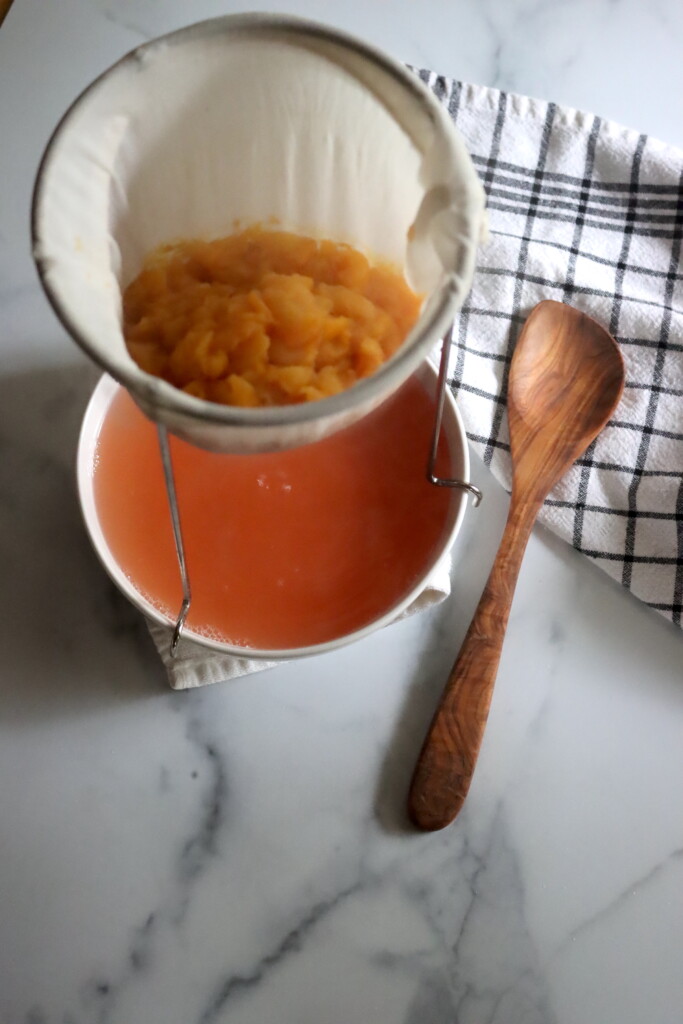
Making Peach Jelly
Once you have your juice, it’s time to get cooking.
In a large pot, combine the 4 cups of peach juice with 1 box of pectin (regular Sure-Jell works well) and 2 tablespoons of lemon juice if your peaches are especially sweet. Bring it to a boil, stirring to dissolve the pectin.
Next, add 4 cups of sugar and bring the mixture to a rolling boil for 1–2 minutes. Stir constantly to prevent scorching. When the jelly reaches the right consistency—thickened, but still pourable—it’s ready to jar up.
Ladle the hot jelly into clean, prepped jars, leaving 1/4 inch of headspace. Wipe the rims, apply the lids, and process in a water bath canner for 10 minutes (add 5 more minutes if you’re above 6,000 feet).
Let the jars cool on a towel undisturbed for 12–24 hours. Once sealed, they’ll keep for up to 18 months in a cool, dark pantry.
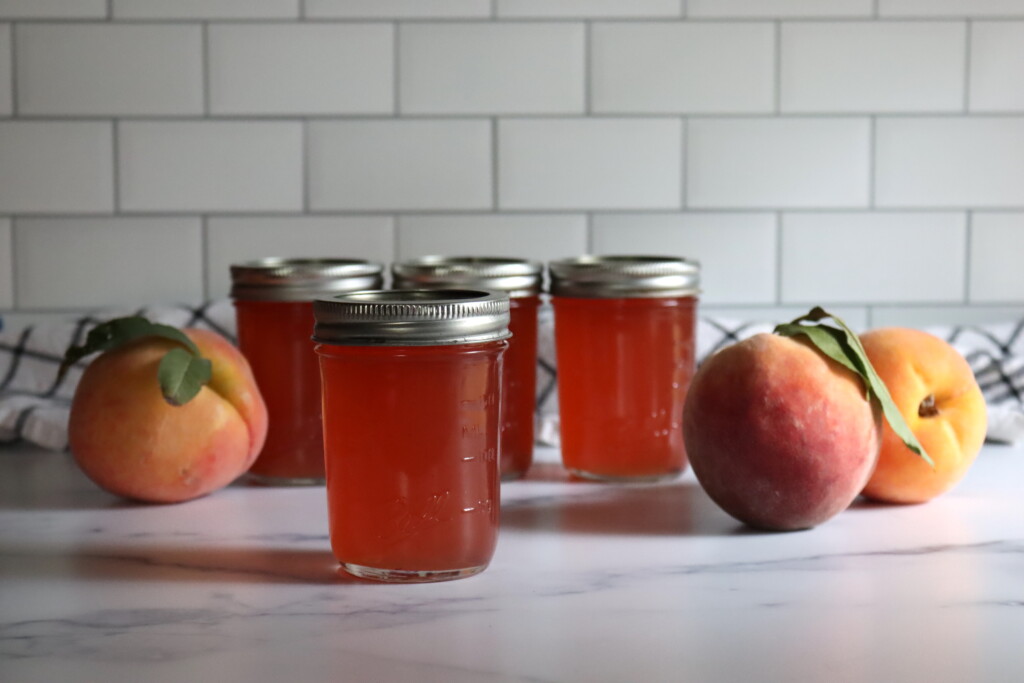
Low-Sugar Peach Jelly
If you’re trying to cut back on sugar, swap in low-sugar pectin and reduce the sugar to 1–2 cups. It will yield a bit less jelly, but you’ll still get that lovely peach flavor without so much sweetness.
Peach Canning Recipes
Stone Fruit Variations
This basic jelly recipe also works beautifully with other stone fruits:
- Nectarine Jelly: Just swap nectarines for peaches, prepared the same way.
- Plum Jelly: Use about 9 medium plums per cup of juice and follow the same steps.
- Apricot Jelly: Takes a good bit more fruit, since apricots give up less juice, but it’s delicious none the less!
- Cherry Jelly: Still a stone fruit, even if they’re smaller, and they make great jelly!
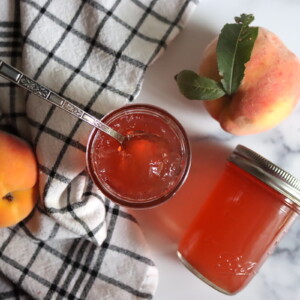
Peach Jelly
Ingredients
- 4 cups peach juice, from about 12 medium peaches and 2 cups water
- 1 box powdered pectin, 1.75 oz pectin or 6 Tbsp (like Sure-Jell)
- 4 cups sugar, for low sugar, see the adjustments below
- 2 tbsp lemon juice, optional—use if your peaches are very sweet and you want a little tartness
Instructions
Extracting Peach Juice
- Prepare the Peaches: Wash your peaches thoroughly. You don’t need to peel them, but it’s a good idea to quarter them and remove the pits if you want to reduce the amount of solids in your juice. However, leaving the pits in is fine for the juice extraction process.
- Cook the Peaches: In a large, stainless steel saucepan, combine the quartered peaches with water. Bring the mixture to a boil over high heat, stirring occasionally. Once boiling, reduce the heat and let it simmer gently for about 20 minutes, stirring occasionally to crush the peaches and release their juices. Be careful not to overcook the peaches, as it can affect the flavor and the strength of the natural pectin.
- Strain the Juice: Once the peaches have softened, it’s time to strain the juice. Place a damp jelly bag (or several layers of dampened cheesecloth) over a large bowl. Pour the cooked peach mixture into the jelly bag or cheesecloth-lined strainer and allow the juice to drip through, undisturbed, for at least 2 hours or overnight. The longer you let it drip, the clearer and more concentrated your juice will be.
Making Peach Jelly
- Prepare Your Jars and Equipment: Wash and prepare jelly jars, lids and rings. Preheat a waterbath canner to just simmering, about 180 F.
- Cook the Juice and Pectin: In a large saucepan, combine the peach juice and water. Add the pectin and stir to dissolve. Place the pan over medium-high heat and bring the mixture to a boil. Stir occasionally, ensuring that the pectin is fully dissolved. Once it’s boiling, allow it to cook for 1 minute.
- Add Sugar and Boil Again: Add the sugar to the pan and stir until it dissolves completely. Bring the mixture to a rapid boil, and let it cook for 1-2 minutes. Keep stirring to prevent burning. If you want to test if your jelly is set, you can do the cold plate test (see the “Tips” section below).
- Fill the Jars: Once the jelly has reached the right consistency (it should be thick but still pourable), remove the pan from the heat. Ladle the hot jelly into your prepared jars, leaving about 1/4 inch of headspace. Wipe the rims of the jars with a clean cloth to ensure a good seal.
- Seal the Jars: Place the lids on the jars and screw on the bands until they are "fingertip tight."
- Process the Jars: Process the jars in a waterbath canner for 10 minutes, or 15 minutes if above 6,000 feet in elevation.
- Cool and Store: Remove the jars from the canner using a jar lifter and place them on a clean towel to cool. Leave them undisturbed for 12-24 hours to ensure that the seals form properly. Once cooled, check the seals by pressing down on the center of the lid—it should not pop back. If it does, the jar didn’t seal, and you can refrigerate it and use it within a few weeks.
Notes
Variations
This recipe works well for other stone fruits as well. Nectarine Jelly: Use the same method to extract juice from nectarines—just substitute nectarines for peaches. Plum Jelly: If you prefer plums, you can substitute them for the peaches, using about 9 plums for every cup of juice.Nutrition
Nutrition information is automatically calculated, so should only be used as an approximation.
Easy Jelly Recipes
Looking for more silky smooth homemade jellies?
- Cherry Jelly – Made from sweet or tart cherries, this jelly has a rich, fruity flavor that’s perfect for toast or pastries.
- Black Raspberry Jelly – Deeply flavored and intensely aromatic, this jelly is a summer favorite made from wild or cultivated black raspberries.
- Gooseberry Jelly – Tart and bright, gooseberry jelly has a unique flavor and sets beautifully thanks to its high natural pectin content.
- Wild Grape Jelly – A homesteading classic, this jelly is made from foraged wild grapes and has a bold, tangy flavor that pairs well with peanut butter or cheese.
Each recipe highlights the best of seasonal fruit and brings a touch of summer to your pantry shelves.
Peach Canning Recipes
If you’ve got a bumper crop of peaches, there are plenty of ways to preserve peaches that go beyond jelly. Here are some of our favorite peach canning recipes to stock your pantry with homemade goodness:
- Peach Jam – A classic spread with bits of fruit in every bite, perfect on toast or stirred into yogurt.
- Peach Butter – Smooth, rich, and deeply flavored, this slow-cooked preserve is perfect for fall breakfasts.
- Peaches in Syrup – Simple canned peach halves or slices preserved in a light or heavy syrup for year-round use.
- Pickled Peaches – Sweet, spiced, and tangy, these are a Southern favorite for serving with meats or cheese boards.
- Peach Salsa – A spicy sweet fruit salsa made with peaches, peppers and onions (no tomatoes required).
These recipes help you enjoy the taste of ripe summer peaches long after the season ends.
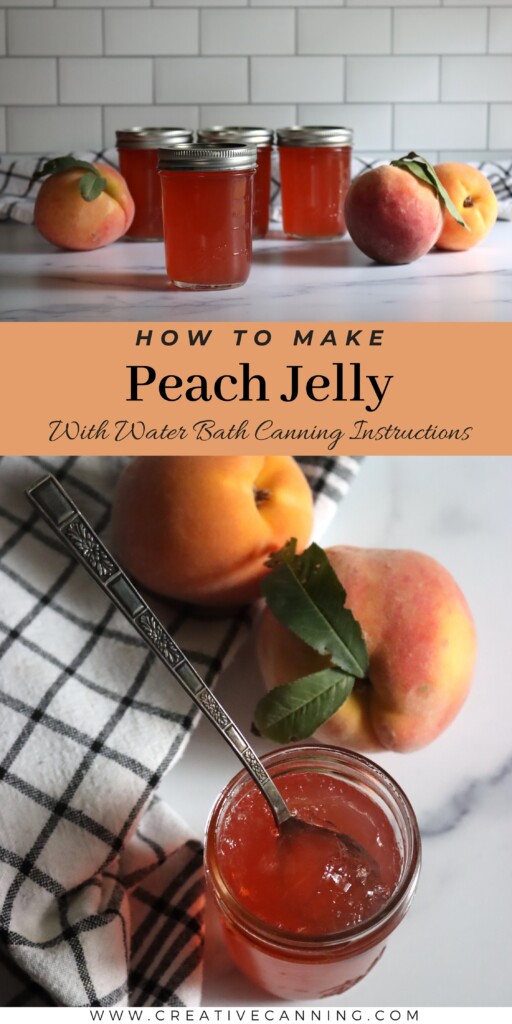
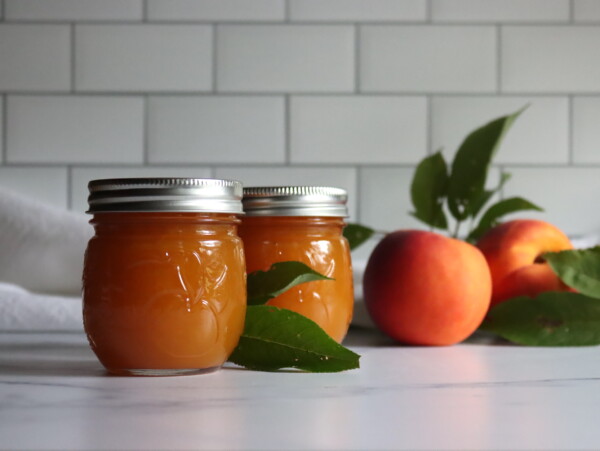
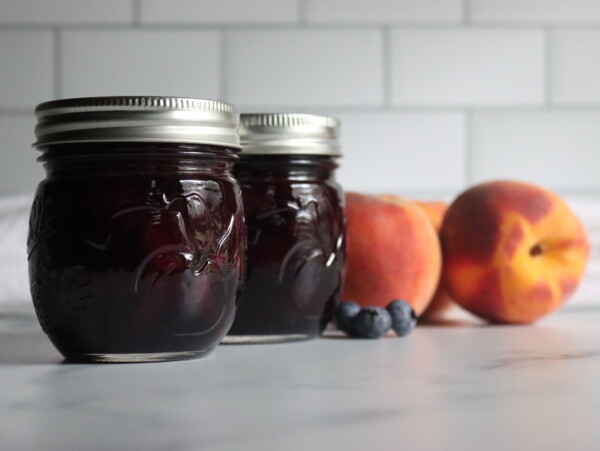
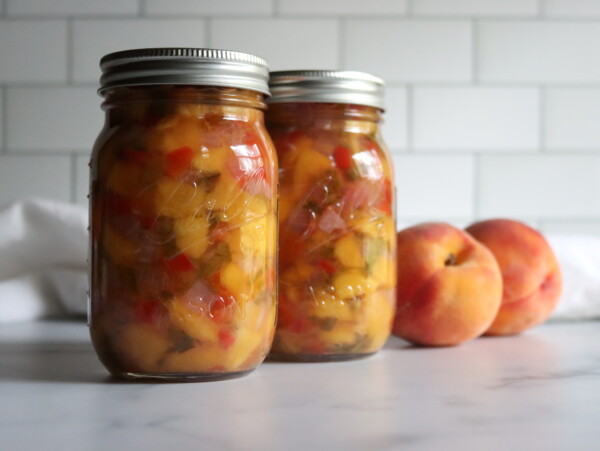
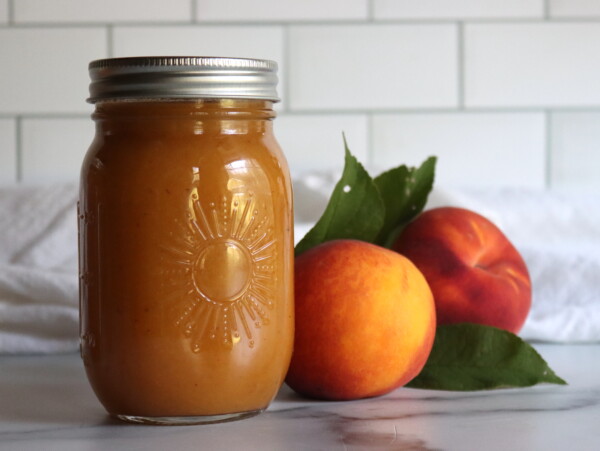
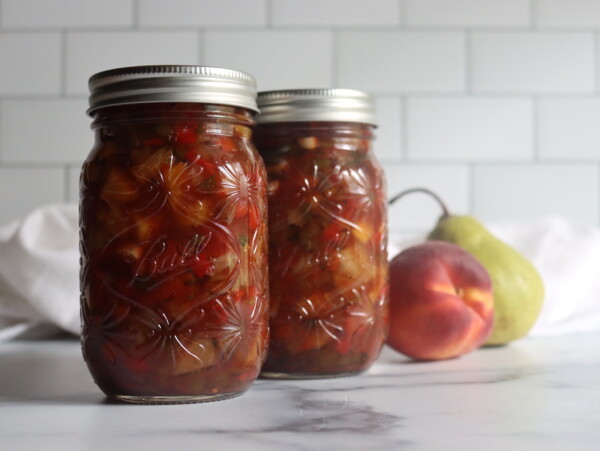
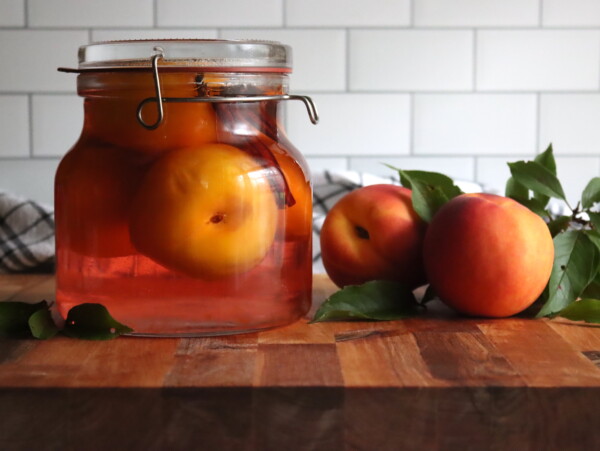
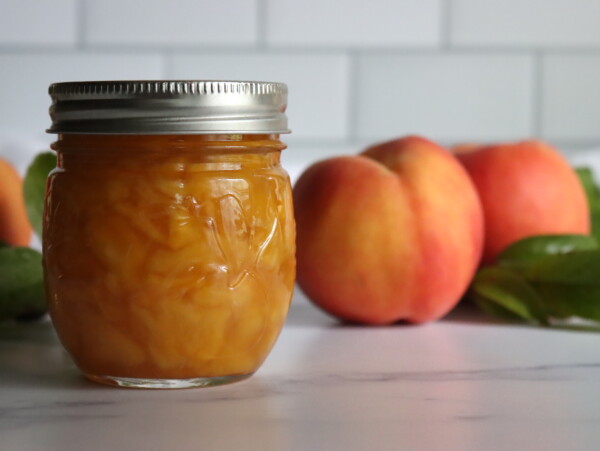
This recipe is phenomenal. I love the flavor of peaches, but don’t care for the “fuzz” on the fruit so I figured I would give this recipe a try and I am glad I did. The flavor is wonderful, the color translucent and the sugar content is less than other peach jelly recipes I researched. This recipe made enough to give to friends and family since I used 4 oz. jars. Thank you for sharing your recipe and knowledge with us!
Wonderful! I’m so glad you liked it. If you like this one, I bet you’ll also like my peach butter recipe too: https://creativecanning.com/peach-butter/
Also not too much sugar, and amazing peach flavor without the fuzz. Enjoy!